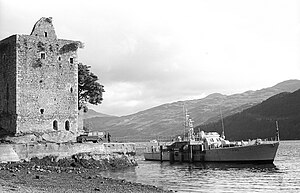Seaward Defence Boat

Droxford at Carrick Castle, Loch Goil 1975
|
|
| Class overview | |
|---|---|
| Name: | Ford class large patrol craft |
| Builders: | Various |
| Operators: | |
| Completed: | 23 |
| General characteristics | |
| Type: | Large patrol craft |
| Displacement: |
|
| Length: | |
| Beam: | 20 ft (6.1 m) |
| Draught: | 6 ft 6 in (1.98 m) |
| Propulsion: |
|
| Speed: | 18 knots (33 km/h; 21 mph) |
| Complement: | 19 |
| Armament: | Depth charge rails with both large and small charges |
The Ford class seaward defence boats were built for the Royal Navy (with 3 built for the South African Navy) in the 1950s. They were designed to detect and attack hostile submarines, including midget submarines in inshore waters such as the approaches to large ports. They were powered by diesel engines and were planned to be armed with a single barreled Squid anti-submarine mortar. This special version of the Squid was a failure however, with the first Ford-class boat, HMS Shalford being fitted with a normal three-barreled Squid and the remaining vessels with a more conventional anti-submarine armament of depth-charge throwers. A single Bofors 40 mm gun completed the armament.
HMS Droxford served for a time as the tender for Glasgow and Strathclyde Universities Royal Naval Unit, and was administered by RNR Clyde. The vessel was used to train Midshipmen who were students of the universities and participated in fishery protection duties along the west coast of Scotland. HMS Beckford (P3104) was renamed HMS Dee and served as the tender to Liverpool University Royal Naval Unit.
...
Wikipedia
